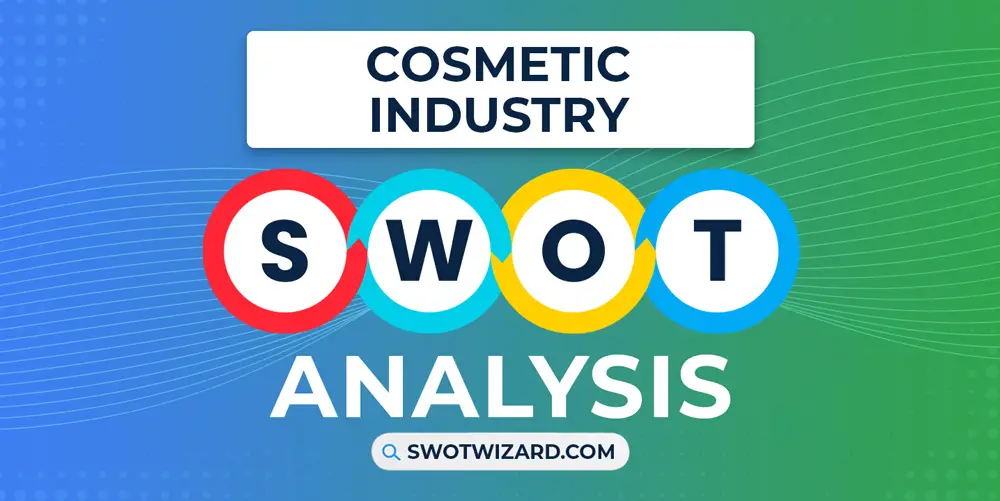The skin moisturizers you use after showering, the shampoo for dandruff, or anything related to maintaining your skin’s betterment is related to the cosmetic industry. Almost every type of skin, hair, makeup, and fragrance product is produced by the industry.
But, with increasing safety concerns, environmental issues, and misleading advertisements, the industry has been facing backlash. Still, in the other corner, there have been some opportunities that we will get to know in this cosmetic industry swot analysis.
Cosmetic Industry Overview
We can trace back the history of cosmetics back to ancient civilizations. The word “cosmetic” came from the Greek word “Kosmetike.” Before, the industry was reserved for a few segments and sectors, but it has seen rapid growth in recent years in every part, such as skincare, makeup, haircare, and fragrances.
The global cosmetics market is valued at $100.5 B in 2022 and is expected to reach $1000 B by 2030, with a compound annual growth rate of 5.93%. The industry employs millions worldwide, with major companies such as L’Oreal, Estee Lauder, and Procter & Gamble operating in multiple countries.
Blessed with rapid globalization effects, the availability of cosmetic products is widespread, with numerous retail channels and e-commerce platforms.
Competitors in Cosmetic Industry
L’Oréal | Unilever | Estée Lauder Cos. | P&G | Coty | Kao | Johnson & Johnson
Did You Know?
The invention of nail polish can be traced back to China in 3000 B.C. They used the egg’s white part, gum, colored powder, and beeswax to make it.
Strengths – Cosmetic Industry SWOT Analysis
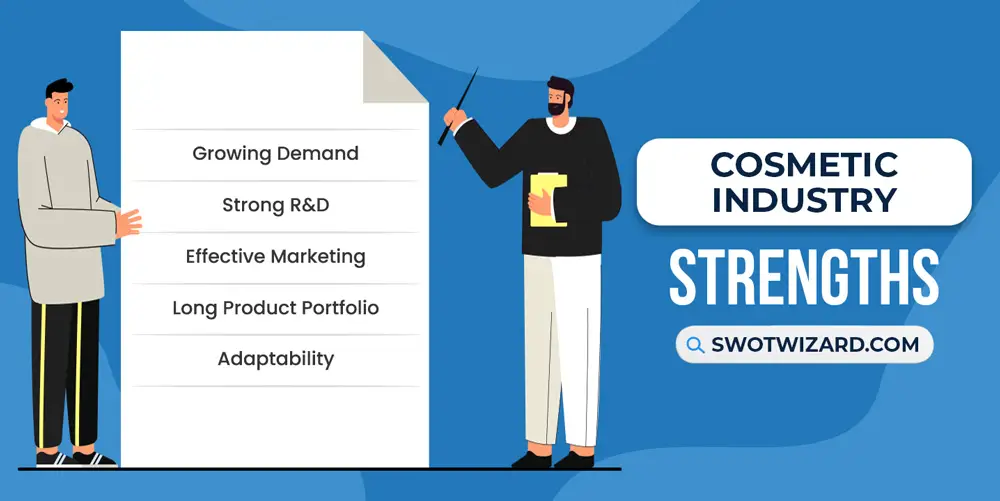
Growing Demand: Currently, the sales volume for the cosmetic industry stands around $50 B in the USA alone in 2022 and more than $350 B globally. A 4.4% global average growth rate and increasing demand for personal care products, including skincare and makeup, will make the industry worth more than $1000 B by 2030.
Strong R&D: As a highly innovative industry, companies invest heavily in research and development to create new and improved products. The industry can’t sustain itself without substantial financial backing and innovative, effective products. For example, one of the biggest companies in this industry, Procter & Gamble Company, has invested $2M alone in R&D.
Effective Marketing: To establish a strong market position, companies invest heavily in branding and marketing to differentiate themselves. As a result, when we think about a particular product, a few cosmetic companies’ names pop up in our minds, thanks to the effective and efficient marketing by the industry.
Long Product Portfolio: Thanks to heavy investment by the companies, now there is every kind of product people can ask for regarding their need for cosmetics. The industry has a long product portfolio, and new and effective products keep entering the market. More than 4000 brands or companies in the cosmetics industry in the USA market exist.
Adaptability: With time, consumer trends and preferences change significantly, especially in the cosmetics industry. To keep up with the pace, they need to be highly adaptable and can quickly respond to what customers want. And depending on that, the industry introduces new products and adjusts its marketing strategies to remain relevant in the market.
Weaknesses – Cosmetic Industry SWOT Analysis
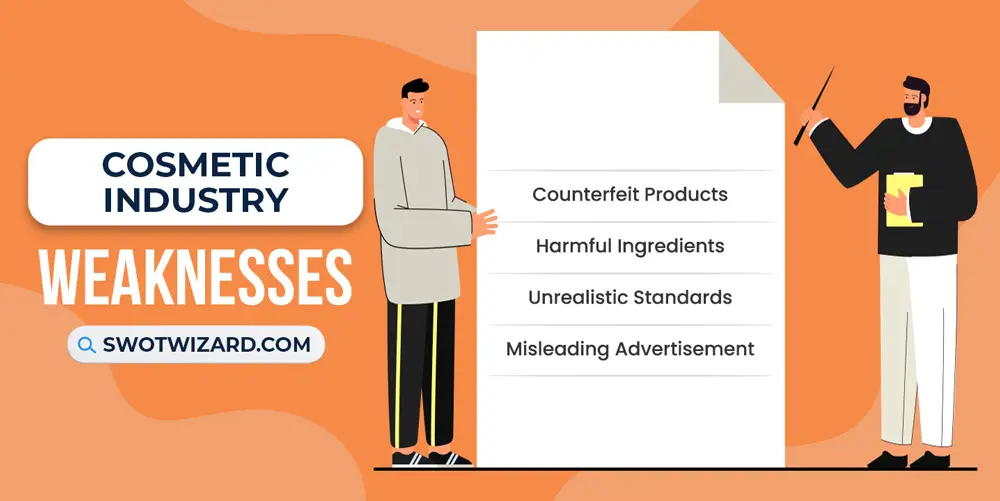
Counterfeit Products: Being an essential, pricey, and everyday item, cosmetics have become a common target to market counterfeit products of these. And the most horrifying thing is that these products are estimated to reach around $75 billion by 2025 in the market, and they can also cause serious health problems.
Harmful Ingredients: Many products in the market might contain ingredients that have been linked to health issues, such as hormone disruption, allergies, and cancer. As a result, many states in the USA, such as California, would ban cosmetics that contain harmful ingredients.
Environmental Pollution: Many cosmetic products contain ingredients that are harmful to the environment, such as microplastics and palm oil. Besides, the industry is known for its heavy use of plastic packaging, and the cosmetic packaging market alone will become more than $57 B by the end of this decade.
Unrealistic Standards: One of the horrible practices of cosmetics companies is that they always portray beauty as related to fairness and encourage using their product in the message. Besides, the cosmetic industry often promotes unrealistic beauty standards, leading to body shaming and other adverse effects on self-esteem.
Misleading Advertisement: Because tons of issues regarding illegal, harmful chemicals, not to mention misleading advertisements or spreading false information to the market, have caused the industry a tremendous amount of time and money. As a result, there are now guidelines that cosmetics companies need to follow to market the products.
Opportunities – Cosmetic Industry SWOT Analysis
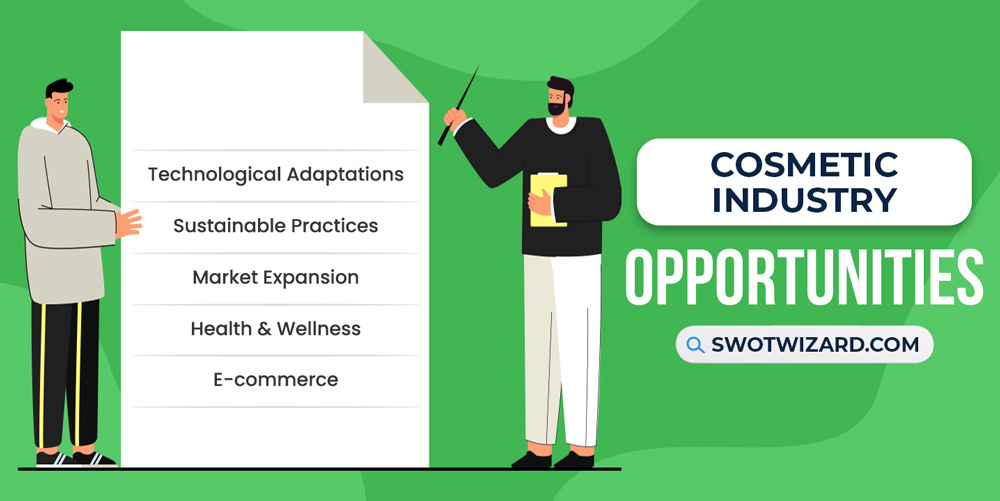
Technological Adaptations: With time, many technologies can help cosmetics companies create more innovative and personalized products, such as AI, Nanotechnology, and 3D printing. Those techs will not just be for analyzing and understanding better but also for serving customers better and more effective products that meet their needs.
Sustainable Practices: Around 120 B units of waste each year have been reported to be wasted, and it is high time the industry starts with better sustainable practices. As consumers are now more biased toward more sustainable practices, it presents an opportunity for cosmetics companies to develop more sustainable and eco-friendly products.
Market Expansion: The global economy is on the rise, and as a part, developing and third-world countries are more exposed to globalization, and new markets are in the growth stage. It is a perfect opportunity for cosmetics companies to expand into emerging markets, such as Asia, Africa, and South America.
Health & Wellness: The entire cosmetic industry runs on various trends, and the new trend is that consumers are now more aware of health and wellness and the impact of cosmetics in their daily life. It is an opportunity for cosmetics companies to develop products that enhance beauty and promote overall health and well-being.
E-commerce: E-commerce not only provides a convenient and accessible way for consumers to purchase products but also allows cosmetics companies to reach a wider audience. As a result, global online cosmetic sales reached $97 B in 2022, around 28% of the total amount. And the pandemic has accelerated this trend, with more consumers turning to online shopping.
Threats – Cosmetic Industry SWOT Analysis
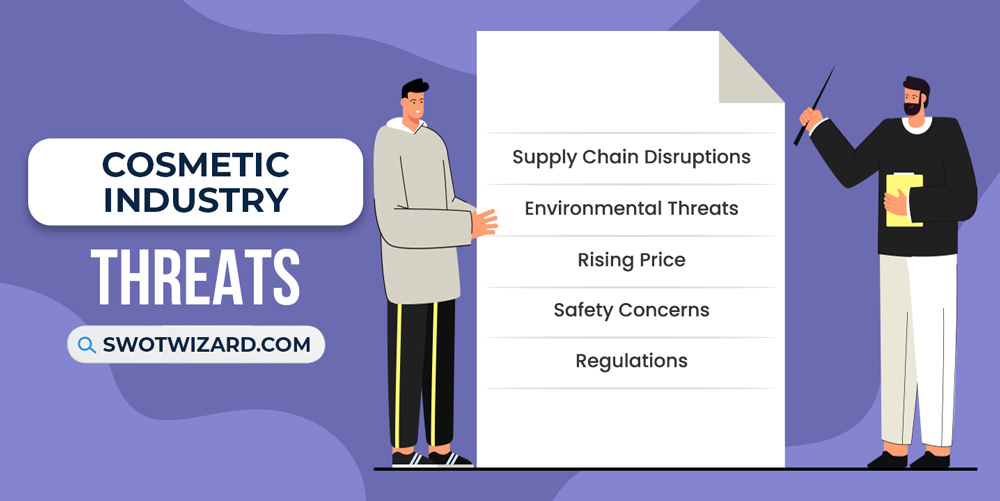
Supply Chain Disruptions: There are many materials that not all manufacturers have available, and relies heavily on complex global supply chains to source raw materials, manufacture products, and distribute them. Any supply chain disruption could cause the companies billions of losses.
Environmental Threats: According to data, the total waste in 2022 in the USA alone was more than 7.9 B units. It’s not just a particular sector or part of the industry; the entire industry has a waste issue. Because of that, the industry has been criticized for its negative environmental impact.
Rising Price: The price of the raw materials in the cosmetic industry was already pricey enough, but due to various factors, such as recession, inflation, supply chain disruptions, and more, the price of the raw materials is increasing, and as a result, the final product price is getting out of hand.
Safety Concerns: Hundreds of reports have been filed against cosmetics companies because of the side effects people face after using their products, which is an ongoing issue. According to the data, cosmetics-related adverse events increased by more than 70% in the last five years.
Regulations: Because of hundreds of complaints against cosmetics companies and to stop counterfeit products, many countries’ governments are taking the matter very seriously and imposing rules that might affect the industry negatively. That’s why recently, the USA has been strict with cosmetic manufacturing companies.
[Bonus Infographic] SWOT Analysis of Cosmetic Industry
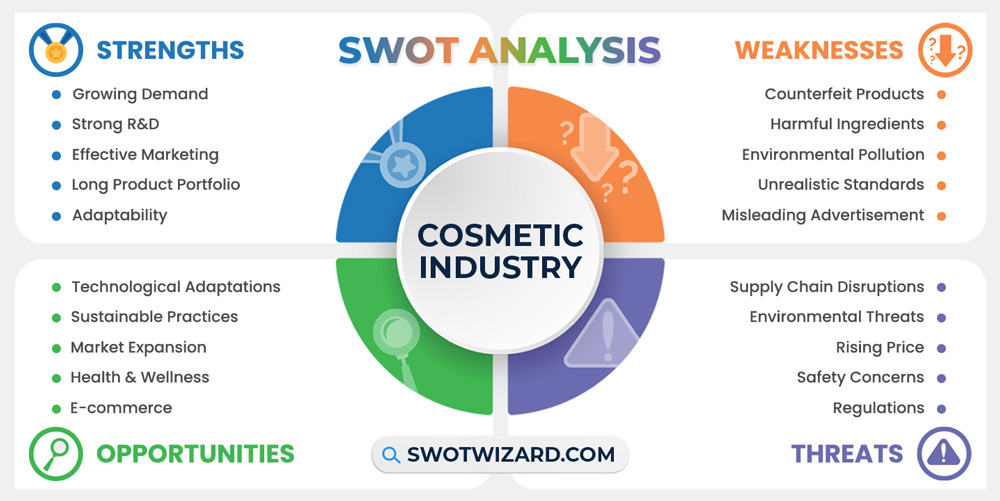
Recommendations for Cosmetic Industry
In the old days, the idea of cosmetic items was simple, but with time it has become one of the most complex subjects. As a result, the industry has been facing challenges, but some new opportunities are around the corner.
- The industry should prioritize sustainability and environmental responsibility, including reducing plastic waste, using sustainable ingredients, and implementing sustainable production practices.
- Continued investment in R&D is crucial to identifying and addressing consumers’ safety concerns and developing innovative products to resolve the issues.
- It is only a matter of time before the industry should prioritize safety and regulatory compliance, including rigorous testing and maintaining global safety standards.
- The pandemic has accelerated the shift towards e-commerce and digital channels, and cosmetics companies must continue to embrace digital innovation.
Frequently Asked Questions (FAQs)
What are the 5 Main Categories of Cosmetic Products?
The five main categories of cosmetic products are makeup, skincare, hair care, oral care, body care, and perfumes.
Is Cosmetic an FMCG?
Yes, cosmetics is an FMCG product.
Final Words on Cosmetic Industry SWOT Analysis
As we can see, the cosmetic industry is a rapidly evolving sector facing challenges and opportunities. It is experiencing a shift towards sustainability and environmental responsibility, with companies investing in sustainable practices. Safety and regulatory compliance remain critical as consumers demand safe and effective products. Lastly, digital innovation is also transforming the industry, with e-commerce and social media driving new ways to reach and engage consumers and continuously battling the issues and government regulations.
References
- Cosmetic Surgery And Service Market 2022 | Growth Demand, Opportunities, Revenue and Forecast To 2030: Advance, Grow and Effective Industry| Marketstrides. (2023, March 6). Digital Journal.
- R&D Expenses For The Procter & Gamble Company (PG). (n.d.). Finebox.
- Cosmetic & Beauty Products Manufacturing in the US. (2023). IBISWorld.
- Kestenbaum, R. (2017, June 19). How The Beauty Industry Is Adapting To Change. Forbes.
- California bill would ban cosmetics with chemicals linked to cancer, reproductive harm. (2023, February 7). Environmental Working Group.
- Cosmetic Packaging Market Will Reach USD 57.1 Billion By 2032, at CAGR 4.6%: Market.Us. (2023, March 6). GlobeNewswire.
- NSF Launches Contents and Claims Certified Guideline for Beauty, Cosmetic, and Personal Care Products. (2023, March 6). BusinessWire.
- Kanade, V. (2023, March 6). What Is Nanotechnology? Definition, Applications, and Use Cases. Spiceworks.
- Clean beauty and sustainability set to lead the fore at in-cosmetics Global. (2023, March 6). Premium Beauty News.
- Wellness trends impacting the beauty industry. (2020, March 3). Mintel.
- Online Sales of Cosmetics 2017—2025. (n.d.). Ecwid.
- Dibachi, R. (2023, February 8). Four Supply Chain Predictions For 2023. Forbes.
- Cernansky, R. (2021, September 16). Beauty has a waste problem, and it’s not packaging. Vogue Business.
- Thorne, G. (2022, September 16). Beauty Products Are the Most Expensive They’ve Been Since 2016. Allure.
- Yang, S., Zheng, Y., Zhang, Y., Ye, C., Yi, J., Liu, Y., & Lai, W. (2019). Cosmetics use-related adverse events. Chinese Medical Journal, 132(17), 2135–2136.
- Cosmetics – Moving From Voluntary Compliance to Mandatory Regulation. (2023, February 24). The National Law Review.

